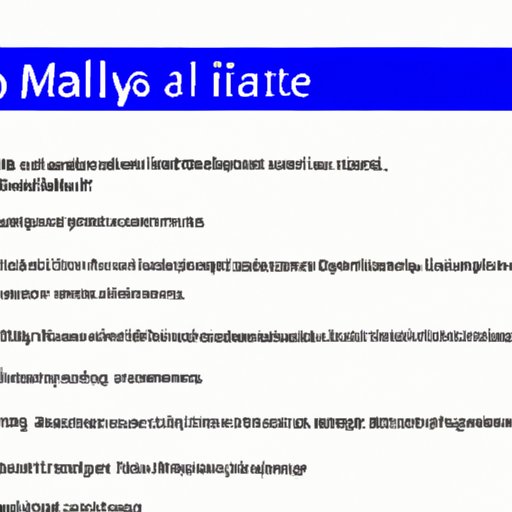Introduction
MLA (Modern Language Association) style writing is a form of writing that is widely used in academic circles. It is a set of guidelines for formatting documents, citing works, and other aspects of academic writing. The purpose of MLA style writing is to ensure uniformity in citation and formatting of documents to create a cohesive paper.

Overview of Components of MLA Style Writing
MLA style writing has several components that must be taken into account when composing a document. These components include formatting documents, in-text citations, and works cited pages. Additionally, it is important to be aware of commonly used sources when citing in MLA style.
Formatting Documents
When formatting documents in MLA style, there are certain rules to follow. For instance, the font size should be 12 pt and the font type should be Times New Roman. Additionally, the margins should be 1 inch on all sides and the text should be double-spaced. These rules create a consistent look throughout a document.
In-Text Citations and Works Cited Pages
In-text citations are an important component of MLA style writing. These citations provide the reader with information about where the material used in the document was obtained. Additionally, a works cited page is required at the end of the document that includes full citations for all of the sources used. This page allows the reader to easily find more information about the sources used in the document.
Commonly Used Sources
When citing in MLA style, it is important to be aware of the types of sources that are commonly used. These include books, journal articles, websites, and other online sources. When citing these sources, it is important to include all of the necessary information so that the reader can easily locate the source.
Differentiating MLA from APA and Chicago Style Writing
When discussing MLA style writing, it is important to note that there are other styles of writing such as APA and Chicago. While these styles have many similarities, they also have some key differences that must be taken into account. It is important to understand these differences in order to properly cite sources and format documents.
Comparisons between the Three Styles
The three main styles of writing are MLA, APA and Chicago. All three of these styles have similarities in terms of formatting documents, citing sources, and other aspects of academic writing. However, there are some key differences between the three styles that must be taken into account.
Key Differences Between MLA, APA and Chicago Style Writing
One of the key differences between MLA, APA and Chicago style writing is the way in which sources are cited. For instance, in MLA style, sources are cited using parenthetical citations, while in APA style, sources are cited using author-date citations. Additionally, in Chicago style, sources are cited using footnotes or endnotes. Another key difference is the way in which titles are formatted. In MLA style, titles are italicized, while in APA and Chicago style, titles are not italicized.

Tips for Writing Effective Documents in MLA Style
When writing documents in MLA style, there are several tips that can help make the document more effective. These tips include utilizing proper grammar and spelling, using easy-to-read fonts, employing correct headings and titles, following appropriate margins, and double-checking punctuation and capitalization.
Utilizing Proper Grammar and Spelling
It is important to utilize proper grammar and spelling when writing documents in MLA style. This helps to ensure that the document is clear and concise and that the reader can easily understand the content. Additionally, it is important to proofread the document before submitting it to ensure that all grammar and spelling errors have been corrected.
Using Easy-to-Read Fonts
When formatting documents in MLA style, it is important to use fonts that are easy to read. Fonts such as Times New Roman, Arial, and Calibri are recommended. Additionally, it is important to use a font size of 12 pt for the body of the document.
Employing Correct Headings and Titles
Headings and titles are an important part of any document written in MLA style. Headings should be numbered and clearly indicate the topic of the section. Additionally, titles should be italicized and contain no more than twelve words. Following these guidelines will help to make the document easier to navigate.
Following Appropriate Margins
When formatting documents in MLA style, it is important to follow the appropriate margins. The margins should be 1 inch on all sides and the text should be double-spaced. Additionally, it is important to leave extra space between paragraphs.
Double-Checking Punctuation and Capitalization
Punctuation and capitalization are an important part of any document written in MLA style. It is important to double-check these elements to ensure that they are correct. Additionally, it is important to pay attention to the placement of commas, periods, and other punctuation marks.
Conclusion
MLA style writing is a form of writing that is used in academic circles. It is a set of guidelines for formatting documents, citing works, and other aspects of academic writing. When writing documents in MLA style, it is important to be aware of the components of MLA style writing, the differences between MLA, APA and Chicago style writing, and tips for writing effective documents. By following these guidelines, writers can ensure that their documents are properly formatted and cited.
Summary of the Main Points
This article provided an overview of the components and tips for effective documents in MLA style. It also compared and contrasted MLA with APA and Chicago style writing. The components of MLA style writing include formatting documents, in-text citations, and works cited pages. Additionally, it is important to be aware of the key differences between MLA, APA and Chicago style writing. Finally, this article provided tips for writing effective documents in MLA style, such as utilizing proper grammar and spelling, using easy-to-read fonts, employing correct headings and titles, following appropriate margins, and double-checking punctuation and capitalization.
Final Thoughts on MLA Style Writing
MLA style writing is a useful tool for academic writing. By understanding the components and following the guidelines, writers can ensure that their documents are properly formatted and cited. Additionally, by being aware of the differences between MLA, APA and Chicago style writing, writers can ensure that their documents are correctly formatted according to the style. By following these guidelines, writers can ensure that their documents are effective and well-written.
(Note: Is this article not meeting your expectations? Do you have knowledge or insights to share? Unlock new opportunities and expand your reach by joining our authors team. Click Registration to join us and share your expertise with our readers.)
